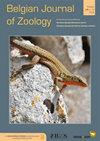A 3D quantitative method for analyzing bone mineral densities: a case study on skeletal deformities in the gilthead sea bream, Sparus aurata (Linnaeus, 1758)
IF 1.1
4区 生物学
Q2 ZOOLOGY
引用次数: 2
Abstract
Skeletal deformities, one of the major threats for aquaculture, have been studied extensively. These include opercular malformations in gilthead sea bream (Sparus aurata), a key fish species for Mediterranean aquaculture. What is causing it and at what morphogenetic level it arises, however, is still unclear. Here we focus on bone formation, at the level of bone mineralization. Several methods have been used to study bone mineralization density (BMD), however, these are frequently limited when targeting a high-resolution, three-dimensional mapping of BMD. We used micro-computed tomography (micro-CT) data to perform such a 3D quantification of BMD levels in gilthead sea bream that showed different levels of opercular bone deformations. This approach has the advantage of not having to rely on calibration phantoms, as long as relative BMD values are needed. The results show an increased BMD in deformed opercles compared to normal ones, especially in a bilaterally-deformed specimen. Furthermore, we show that opercular deformations are not necessarily associated with similar mineralization patterns in other mineralized cranial elements, except for the otoliths. Also, mineralization seems to occur left-right independently, matching earlier observations of such an independency of the opercular phenotype as a whole. This study confirms that a quantitative characterization of BMD patterns in 3D is feasible, even in smaller specimens, and that it has several advantages over other commonly used approaches.一种分析骨矿物质密度的三维定量方法:以金头鲷(Sparus aurata)骨骼畸形为例(Linnaeus, 1758)
骨骼畸形是水产养殖的主要威胁之一,已被广泛研究。其中包括地中海水产养殖的主要鱼类——金头鲷(Sparus aurata)的眼周畸形。然而,究竟是什么原因引起的,以及在什么形态发生水平上产生的,目前还不清楚。这里我们关注骨形成,在骨矿化水平。已有几种方法用于研究骨矿化密度(BMD),然而,这些方法在针对BMD的高分辨率三维绘图时经常受到限制。我们使用微型计算机断层扫描(micro-CT)数据对显示不同程度的眼周骨变形的鳙鱼的骨密度水平进行了三维量化。这种方法的优点是,只要需要相对BMD值,就不必依赖校准幻象。结果显示,与正常的骨密度相比,变形的骨密度增加,特别是在双侧变形的标本中。此外,我们发现除了耳石外,其他矿化颅骨元素的眼状变形不一定与类似的矿化模式有关。此外,矿化似乎是左右独立发生的,这与早期观察到的整个眼型的独立性相匹配。该研究证实,即使在较小的标本中,3D骨密度模式的定量表征也是可行的,并且与其他常用方法相比,它具有几个优势。
本文章由计算机程序翻译,如有差异,请以英文原文为准。
求助全文
约1分钟内获得全文
求助全文
来源期刊

Belgian Journal of Zoology
生物-动物学
CiteScore
1.90
自引率
0.00%
发文量
10
审稿时长
>12 weeks
期刊介绍:
The Belgian Journal of Zoology is an open access journal publishing high-quality research papers in English that are original, of broad interest and hypothesis-driven. Manuscripts on all aspects of zoology are considered, including anatomy, behaviour, developmental biology, ecology, evolution, genetics, genomics and physiology. Manuscripts on veterinary topics are outside of the journal’s scope. The Belgian Journal of Zoology also welcomes reviews, especially from complex or poorly understood research fields in zoology. The Belgian Journal of Zoology does no longer publish purely taxonomic papers. Surveys and reports on novel or invasive animal species for Belgium are considered only if sufficient new biological or biogeographic information is included.
 求助内容:
求助内容: 应助结果提醒方式:
应助结果提醒方式:


